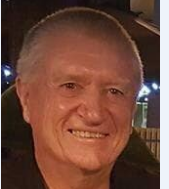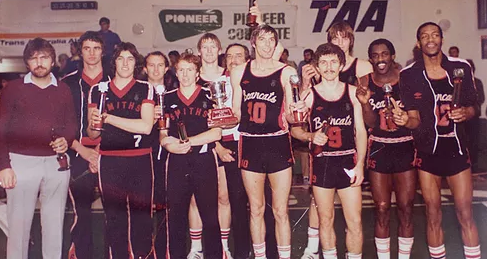BK and LLL into BQ HoF, at long last
TweetBRIAN Kerle and Leroy Loggins may be two of the biggest and greatest names in the history of Queensland basketball, but both also retain massive legacies in two other great states, Victoria and South Australia respectively.
Queenslander Kerle headed south to Melbourne in the Sixties to better himself as a ball player because at that time, the VBA competition was the best in Australia.
At 6-9 (yeah, that’s 206cm now but it was 6ft9in back then), he was tall, lanky, full of enthusiasm and aware he had much to learn.
He helped drive St Kilda Saints to recruit larger-than-life fellow Basketball Australia/NBL Hall of Famer Ken Cole as its playing coach post the 1968 Olympics and was instrumental in turning that club into a Victorian and national powerhouse.
Kerle the player was a Victorian state rep who then represented Australia as a Boomer at FIBA’s 1970 World Championship and the 1974 FIBA World Championship. In between, he was a 1972 Munich Olympian.
 It was Kerle midway through the second half of the historic inaugural Grand Final of the Australian Club Championship at Albert Park Stadium in 1970 who turned it on its ear.
It was Kerle midway through the second half of the historic inaugural Grand Final of the Australian Club Championship at Albert Park Stadium in 1970 who turned it on its ear.
Melbourne Church was in complete control, Rocky Crosswhite devastating with his elbow jumpshots, Lindsay Gaze on fire and Billy Wyatt shutting down Saints scoring sensation Eddie Palubinskas.
Church was ahead by 19 when Kerle intercepted a pass at the wing and took the ball the length of the floor to throw down a vicious dunk.
You have to remember, back in the late-60s and early 70s, dunks were as rare as tattoos so when Kerle broke down the floor and hammered one down, it was an emphatic statement which brought the entire packed stadium to life.
It also sparked St Kilda, which rallied to claw its way all the way back – Albert Park in full roaring voice - before Melbourne found its composure sufficiently to hang on for a two-point win.
St Kilda won the Victorian championship but again in 1971, it was Melbourne which took the ACC, the Saints finally breaking through in 1972.
They won it again in Adelaide in 1975, Cole having moved to South Australia and David Lindstrom spearheading another Kerle-led team to the ACC crown.
Kerle’s elevation to St Kilda coach came as no huge shock and when the NBL launched in 1979, he claimed the first championship with what was then – and still remains - a most historic win as it was achieved with a completely Australian-born team.
Yup. No imports. None.
In 1980 when Kerle took St Kilda to back-to-back championships, he additionally had the silky smooth skills of American shooting guard Rocky Smith, the league MVP and still one of the greatest two-men to play NBL basketball.
 Fast forward to 1981 and Kerle’s St Kilda won the NBL’s regular season championship a comfortable three wins clear of Launceston Casino City in second.
Fast forward to 1981 and Kerle’s St Kilda won the NBL’s regular season championship a comfortable three wins clear of Launceston Casino City in second.
No-one doubted it would be a Saints threepeat but the club was invited to Brazil to contest what was going to be the first World Club Championship and when that clashed with the NBL’s playoff dates, the league went out of its way to ensure it would not accommodate St Kilda in any way.
When you look now at the NBL willingly taking recesses in-season to accommodate FIBA World Cup qualifying windows, or working around preseason games with NBA teams or even in 1999 allowing Adelaide 36ers in-season to attend the McDonald’s World Cup in Milan, Italy, it does your head in to recall the pettiness and small-mindedness of early 80s administrators.
The prevailing thinking, obviously, was here was a chance to break St Kilda’s apparent stranglehold on its #1 status in Australia by ensuring there must be a new champion in the Saints’ absence.
As it turned out, after Brazil, St Kilda’s domination dwindled naturally anyway and Kerle headed home to become the face of a revitalised and success-bound Brisbane Bullets franchise.
His record in Queensland is impeccable, with Grand Finals in 1984-85-86-87-90 and championships in 1985 and 1987.
While Kerle still was leaving his mark in Victoria, Brisbane’s NBL program recruited a skinny New Jersey-born 6-6 kid named Leroy Loggins for the 1981 NBL season.
The day West Adelaide Bearcats’ player-coach Ken Richardson saw Loggins play against his team, he declared he had just seen the best American import in the NBL.
His words could not have been more prophetic, Loggins winning the MVP award three times, perennially rated as the #1 import and #1 player in the NBL’s 40-year history.
Richardson lured Loggins to West ahead of the 1982 season and he averaged 25.2 points at 57 percent as the Bearcats stormed to the championship.
WEST'S 1982 NBL CHAMPION: With Leroy Loggins, far right.
To date it is the only NBL champion to boast three MVPs in its lineup - Richardson, Loggins and Al Green.
Green claimed the MVP in the championship season and Loggins the Grand Final MVP. Back home in Adelaide, Loggins was instrumental in the Bearcats winning the state championship, their record fifth in a row.
In 1983, after West lost the NBL Grand Final to Canberra Cannons, it came home and also lost the state championship Final..png)
But Loggins was named the 1983 Woollacott Medallist, the medal decided on a similar system to AFL’s Brownlow Medal, on referees’ 3, 2, 1 votes.
The Woollacott Medal is the most prestigious individual accolade in South Australian men’s basketball, declaring Loggins the league’s fairest and most brilliant player.
No argument there.
These days, to win an NBL Championship, a team has to go through Perth Wildcats.
In the 80s, it was through Leapin’ Leroy Loggins, Triple-L - the heavyweight superstar - competing in six consecutive Grand Final Series from 1982-83-84-85-86-87 and again in 1990.
The joy of watching Leroy was in appreciating his joy. Never a basketball player with a sour or dour expression, Leroy’s pure joy at swishing threes, stealing the ball, monstering a rebound, throwing down a dunk was infectious and a key reason basketball rose out of rinky-dink stadiums and into entertainment centres during his time at the top.
Naturalised and settling in Australia, Loggins was selected for the Boomers and competed at the 1992 Barcelona Olympic Games for his adopted homeland.
It was the Games of the USA “Dream Team” but pairing Loggins and Andrew Gaze in the green-and-gold was a dream for Aussie basketball fans too.
Basketball Queensland announcing both Kerle and Loggins would later this month be inducted into its Hall of Fame together – their lives are inextricably and forever linked, they even went into the BA/NBL Hall of Fame together in 2006 – is long overdue recognition of the two men who put the sport on the map in Brisbane.
Kerle was the coach and entrepreneur, Loggins the superstar who brought hordes through the turnstiles with his versatilty, skill and passion.
Basketball, not just in Queensland but around Australia, owes both icons quite the debt.


